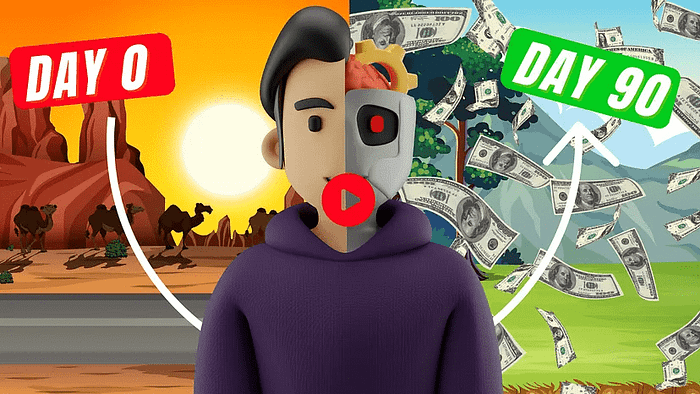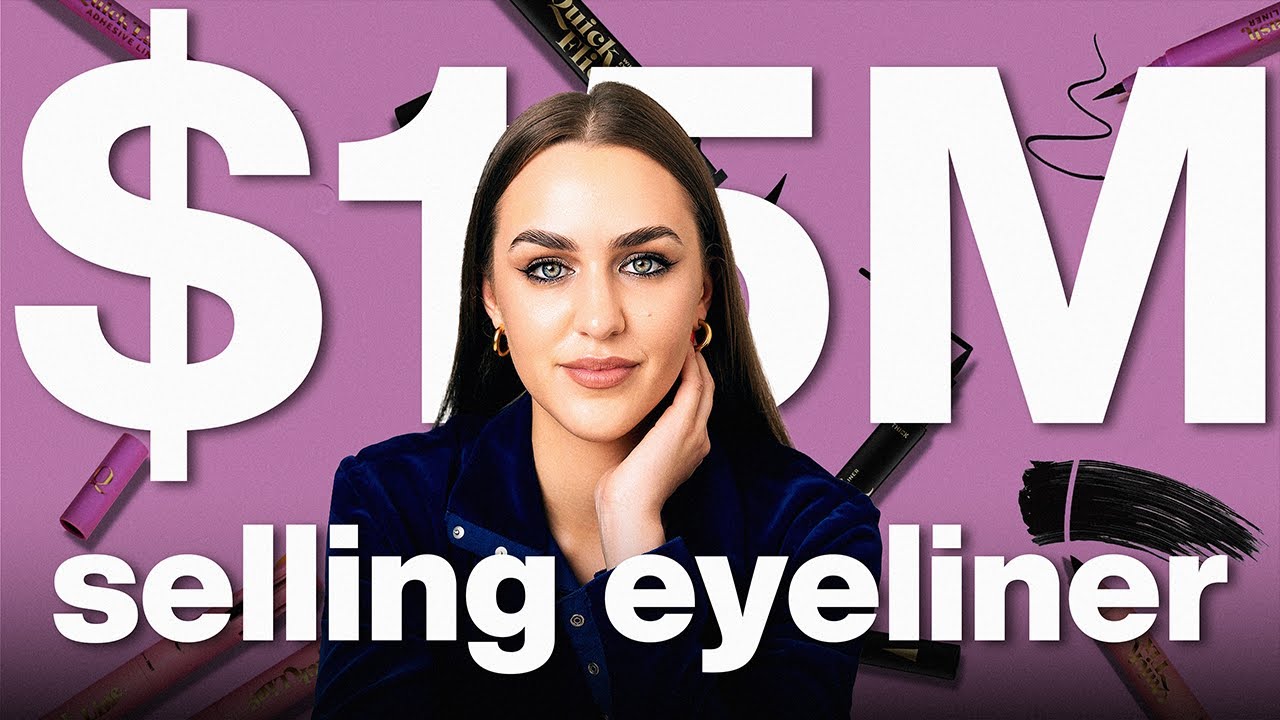How To Scale From $0 to $15M Selling Eye Liner: Iris Smit’s Journey
Introduction: The Birth of Quick Flick
Entrepreneurship often begins with identifying a problem that needs solving, and this was precisely the case for Iris Smit in 2017.
While studying architecture in her final year, during a mid-semester break of about six weeks, she birthed a brand that would revolutionize the beauty industry.
At the time, she was running an e-commerce business for her then-boyfriend and developed a taste for the business world.
E-commerce was experiencing significant growth, and she desired to create something of her own.
With a passion for makeup and design from her architecture background, she noticed winged eyeliner trending globally.
Everyone seemed to be wearing winged eyeliner, featured in countless YouTube tutorials, yet many struggled with application.
This observation prompted her to search for a product that would simplify the application process.
Finding nothing suitable, she opened her architecture software to create a winged eyeliner shape, located a manufacturer to model it, designed packaging, built a website, and established social media presence—all within six to eight weeks.
We strongly recommend that you check out our guide on how to take advantage of AI in today’s passive income economy.
Table of Contents
Deep-Rooted Motivation
Behind this entrepreneurial drive lay deeper motivations that only surfaced years later during intensive therapy.
The creation of her brand served as a means of reclaiming ownership and identity—aspects that had been challenged throughout her childhood.
Growing up in a household with domestic violence, she often felt worthless and trapped in a toxic cycle of constantly trying to prove herself.
She measured her human value by success, treating business creation as an outlet to process trauma.
Initially, this approach proved unhealthy, and a few years into her business journey, she hit rock bottom.
She realized she was using her business to process trauma, which wasn’t effective.
This led to a pivotal moment where she had to rebuild her entire business from scratch after working through her childhood trauma.
Early Business Days
The Quick Flick launched in 2017 with $10,000 in savings while Smit juggled university studies.
The first product, the winged eyeliner stamp, entered a market with less competition than today.
The advantage of a completely unique, first-of-its-kind product secured her an innovation patent.
The timing couldn’t have been better, with winged eyeliner becoming the dominant makeup trend.
However, success wasn’t immediate—the first day generated only $800 in sales, mostly from friends and family.
Growth remained slow during the initial four months as she balanced full-time work, university, and entrepreneurship.
The breakthrough came when key influencers featured the product in their videos, during a time when one influencer mention could generate $10,000 in sales within an hour.
This catalyst of events continued when a Daily Mail writer saw an influencer video, wrote an article, which Shark Tank producers noticed and reached out about audition possibilities.
Momentum Building
Early 2018 saw significant growth, primarily driven by influencer usage and organic PR rather than paid advertising.
The business truly exploded when Huda Kattan, founder of Huda Beauty with approximately 13 million followers at the time, featured the product.
This single exposure resulted in nearly $50,000 in sales on the first day—a dramatic increase from their typical $2,000 daily average.
By February 2018, Smit filmed her Shark Tank episode, though it wouldn’t air until early June.
During this interim period before broadcast, business momentum accelerated dramatically with retailers reaching out, largely driven by social media and influencers incorporating the eyeliner stamp into makeup tutorials.
The Shark Tank Experience
Interestingly, Smit never initially applied for Shark Tank—the producers discovered her through the Daily Mail article.
She hadn’t considered herself established enough, harboring negative self-talk and limiting beliefs.
When she received the email invitation, she initially dismissed it as a scam, deleted it, then retrieved it but missed the audition deadline.
A late-night impulse prompted her to film a raw video on her iPhone and submit it.
The producers appreciated the authenticity of her submission, leading to her appearance on the show.
Though she received and initially accepted an offer for $300,000, she ultimately declined it as circumstances had changed significantly during the months between filming and airing.
Sales doubled monthly, and major retailer Priceline approached her with point-of-sale materials ready for distribution.
The valuation had transformed completely, making the original deal less suitable for her growing business.
Hitting Rock Bottom Amid Success
Counterintuitively, Smit began experiencing her lowest point around the Shark Tank period—when external indicators suggested peak success.
On paper, everything appeared perfect: Shark Tank appearance, thriving business, growing team.
However, she operated from an unhealthy mindset, believing happiness would arrive upon reaching specific milestones.
When achievements didn’t bring fulfillment, exhaustion set in.
She hadn’t addressed childhood trauma, living in denial without therapy or meaningful conversations about her past.
Her internal dialogue insisted she was broken beyond repair due to her experiences.
This negative mindset persisted while pursuing achievements, hoping they would eventually bring happiness.
One particularly dark night, driving home late, she wished for a “reset button” on her life—a wake-up call that prompted her to prioritize mental health and seek professional help.
Business Transformation Through Personal Growth
What followed was nearly two years of intensive therapy twice weekly, resulting in profound personal transformation.
The business structures, team members, and operational approaches created by the “old Iris” no longer aligned with the “new Iris” emerging from therapy.
This necessitated a comprehensive restructuring of her business operations, hiring practices, and overall approach.
Initially, like many entrepreneurs, she hired friends, family, and acquaintances without necessarily selecting the right talent.
Her negative energy at that time attracted similar people into her orbit.
As she progressed through therapy and personal growth, the disconnect between her evolved self and her business environment became increasingly apparent.
She replaced team members, abandoned the traditional office model, and embraced remote work—shedding the ego-driven image of success tied to physical office space and centralized operations.
Strategic Product Diversification
By late 2019, Smit launched her second business, The Beauty Fridge, strategically timed as skincare gained popularity.
When COVID-19 arrived, people sought home organization products during lockdowns, fueling rapid growth.
She implemented a split distribution model with in-store availability at Target and Priceline while maintaining online sales.
The Beauty Fridge ultimately served as more than just a second revenue stream—it became crucial financial support during Quick Flick’s transition from cosmetics to skincare products.
As consumer preferences shifted away from heavy makeup toward skin health and natural looks during the pandemic, Beauty Fridge sustained the business while Quick Flick developed innovative products like sunscreens, eventually reclaiming its market position.
Marketing Strategy in a Competitive Landscape
Despite bootstrapping with limited marketing budget, Smit successfully differentiated Quick Flick in the crowded beauty space through several key strategies.
First, she leveraged founder profile and messaging, actively sharing behind-the-scenes glimpses of business operations and product development on social media.
She began this approach before it became common practice, involving customers in decision-making processes like shade selection, creating an engaged community.
Her branded content focuses relentlessly on problem-solution dynamics—showing a problem visually (like white sunscreen sprayed over makeup) followed immediately by the solution (their clear application product).
This hook-based, short-form content effectively captures attention in seconds, addressing viewer problems quickly before guiding them to more educational, in-depth content.
She emphasizes that business creation itself provides fascinating content—showing lab visits, packaging design, and development processes builds anticipation and customer investment in forthcoming products.
Product Development Philosophy
Smit’s approach to identifying product opportunities stems primarily from customer feedback and market gaps.
She listens attentively to customer struggles and product shortcomings, including reviewing competitor feedback to identify unmet needs.
For example, the sunscreen innovation originated from customers expressing difficulty reapplying sunscreen over makeup.
Crucially, she designs products with marketing in mind—considering how a product will appear in social content, creating visual “hooks” that will capture attention in the first two seconds of a video.
The distinctive domed lids of their sunscreen products exemplify this thinking—standing out on retail shelves and generating social media comments about unique packaging.
Similarly, she designed a tanning mousse applicator resembling whipped cream, knowing the visual would consistently generate viral content—videos featuring this application reliably attract millions of views.
Bringing Products to Life
Despite running a lean team, Smit personally handles most product development rather than outsourcing to agents.
Years of experience have refined her ability to design products with viral potential.
She sources manufacturers herself, engaging cosmetic chemists for formula development while maintaining oversight throughout the creation process.
Some projects require only one chemist and ten iterations, while others demand multiple specialists and over 100 samples.
Development timelines vary significantly—from one month to over a year depending on product complexity.
She selects manufacturers across Australia based on their specialization, matching each product with factories experienced in similar categories.
This expertise-focused approach streamlines development considerably compared to working with generalists.
Navigating Minimum Order Quantities
Like many entrepreneurs, Smit faced minimum order quantity (MOQ) challenges when starting out.
Her first product order was negotiated down to 800 units from an initial 1,000 requirement—a number that seems minuscule compared to today’s typical MOQs of 10,000-20,000 units or minimum purchase requirements of $100,000.
For those starting out, she recommends exploring manufacturers with lower MOQs (some will accommodate 5,000 units) and employing cost-saving measures like using stickers rather than custom packaging initially.
She advocates honest communication with manufacturers about starting circumstances, forecast growth, and requesting accommodation on first orders.
Many manufacturers, understanding business realities, will work with promising brands if approached transparently.
Growth Strategy and International Expansion
When determining whether to focus on existing products versus launching new ones, Smit balances several factors.
Sometimes retailers approach her directly requesting specific category innovations, as occurred when Coles asked her to “shake up” the tanning category following her success in suncare.
Customer feedback provides another important signal—the transformative sunscreen spray originated from listening to expressed needs but delivering beyond exactly what customers requested.
For international growth, she focuses on proven products rather than creating market-specific offerings.
Current expansion priorities include the United States, United Kingdom, Europe, and parts of Asia, with each market receiving carefully selected products with demonstrated success and transferability across cultures.
Remote Work and Lifestyle
Unlike many growing e-commerce brands that maintain traditional offices, Smit operates completely remotely.
This approach evolved from seeing other successful entrepreneurs maintain location independence while building substantial businesses.
She typically works 8-9 hours daily, starting around 8-9am and finishing around 6-6:30pm—a schedule she finds fulfilling rather than burdensome.
The remote model emerged partly from questioning conventional business structures with the same innovative mindset she applies to product development.
After witnessing friends and podcast-featured entrepreneurs build $100M+ businesses with small, fully-remote teams, she challenged herself to reimagine her company structure just as radically as her product innovations.
Vision for the Future
Looking ahead, Smit aims to continue Quick Flick’s current trajectory with ongoing category innovation.
Customer problems provide endless opportunities for new solutions, with hair care emerging as a potentially exciting new category based on recent customer requests.
She remains particularly passionate about revolutionizing sun care, motivated by Australia’s rising skin cancer rates.
Her final advice centers on questioning conventional approaches to business—examining whether your vision truly reflects your authentic desires rather than external influences or ego-driven perspectives.
She encourages entrepreneurs to clarify their values and attract team members who share those priorities, creating an aligned organization that supports sustainable growth.
Key Takeaways for Aspiring Entrepreneurs
The journey from $0 to $15M selling eyeliner illuminates several crucial lessons applicable across industries.
First, successful innovation often begins with identifying genuine user frustrations and creating elegant solutions.
Second, founder storytelling and community involvement create stronger customer relationships than traditional marketing approaches.
Third, visual marketing hooks designed during product development (not as an afterthought) drive organic growth.
Fourth, personal development directly impacts business success—unresolved issues eventually manifest in business operations.
Fifth, challenging conventional business structures can reveal more efficient, lifestyle-compatible approaches to scaling.
Finally, authenticity and vulnerability in leadership attract the right team members and foster loyal customer communities—turning product purchases into participation in a larger mission.
This transformation from architecture student to multi-million dollar beauty entrepreneur demonstrates how solving a seemingly simple problem (applying eyeliner) can create category-defining businesses when approached with genuine innovation and relentless improvement.

We strongly recommend that you check out our guide on how to take advantage of AI in today’s passive income economy.




